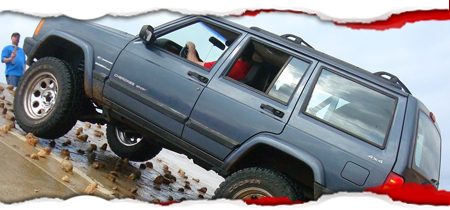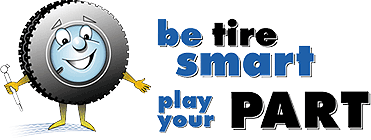
Cooper Brings Two New Tires to Market for SUVs, CUVs, and Light Trucks
with Quality and Value,
plus Gives Tire Care Basics
By Sue Mead
Let’s face it: Most drivers pay little-to-no attention to their tires. While many motorists who reside in winter climes change their all-terrain or everyday tires for snow tires in the inclement-weather season, few consumers know how to evaluate tires and make the best decision for a replacement tire. And, an even smaller number know the rules of tire care basics and safety. (See below)
A group of automotive journalists recently joined some tire-testing professionals, including Indy Car’s Johnny Unser and racing champion Ali Ajibouri, two of the technical advisers that assess tires at the Cooper Tire and Vehicle Test Center, in Pearsall, Texas. Cooper is the forth-largest tire manufacturer in the U.S. and the ninth-largest in the world and makes tires for autos, motorcycles and commercial vehicles, with specialty tires for ultra-high performance and motorsports, competing in every level from grassroots club series to Formula One, Le Mans, drag racing, rally cross and ice racing. In fact, Cooper is a tire sponsor for more than 150 race series.
While Cooper’s 1000-acre site has four areas used for reviewing and measuring new and varied tire products, our main task was tryout two all-new tires for the sport utility vehicle (SUV), crossover utility vehicle (CUV), and light truck market, one of the biggest and most popular segments of the automotive market in America. This meant that we spent time on a wet handling course and on the off-road test courses, evaluating the capabilities of Cooper’s new all-terrain Discoverer A/T 3 and the new Discoverer S/T MAXX, made for buyers that use their vehicles in locations and conditions which require a more aggressive tire with superior traction.
Just launched, the Discoverer A/T3 is the latest addition to Cooper's SUV and light truck tire lines and is the replacement for the Discoverer ATR. The tire maker’s engineers worked their mojo with various technologies, compounding and design to develop a new tire that provides sure-footed performance as an all-terrain tire. Cooper’s engineers have created a silica tread compound that increases treadwear, improves wet traction and helps resist cutting and chipping. In addition, the new design significantly improves off road traction without sacrificing highway performance. The A/T3 comes in 30 SUV sizes and 32 light truck sizes ranging from 15 to 20 inch rim diameters.
Cooper’s new tire for consumers that need more assertive rubber under their vehicle is the Discoverer S/TMAXX that will replace their successful Discoverer S/T-C and selected sizes of the Discoverer S/T. It was developed with Cooper’s 3-ply "Armor-Tek3" carcass construction, a new proprietary cut and chip resistant tread compound and an aggressive tread design. This commercial grade traction tire will perform in the toughest terrains, for buyers who work in construction, on ranches and farms, and spend time in the backcountry. On sale now, it comes in 8 sizes ranging from 16 to 18 inch rims.
So, what did we learn during our day at Cooper Tires? We judged the newest tires from Cooper in deep mud, over rock climbs, and through soft-surface traction areas, as well as on high-speed wet traction and handling courses. All are designed to simulate real world driving, in general, and in extreme conditions, as well. Our group found that both new tires are innovative and competent, but also quiet, despite their aggressive tread. We encourage you to check them out for yourselves. With “value” pricing and a 50,000 mile treadware warranty, we’ll let you be the judge!
Tire Safety Tips from Cooper
Tires are designed and built with great care to provide thousands of miles of excellent service. But for maximum benefit they must be maintained properly.
The most important factors in tire care are:
Proper inflation pressure
Proper vehicle loading
Proper tire wear
Regular inspection
Good driving habits
Vehicle conditions

Proper tire care and safety is simple and easy. The Rubber Manufacturers Association (RMA) recommends getting in the habit of taking five minutes every month to check your tires, including the spare.
 Pressure
Pressure |
Under-inflation is a tire's #1 Enemy.
It results in unnecessary tire stress, irregular wear, loss of control and accidents. A tire can lose up to half of its air pressure and not appear to be flat!
|
|
|

Alignment
|
Is your vehicle pulling to one side, or shaking?
A bad jolt from hitting a curb or pothole can throw your front end out of alignment and damage your tires. Have a tire dealer check the alignment periodically to ensure that your car is properly aligned.
|
|
|

Rotation
|
Promotes uniform tire wear.
Regularly rotating your vehicle's tires will help you achieve more uniform wear. Unless your vehicle owner's manual has a specific recommendation, the guideline for tire rotation is approximately every 5,000 miles. |
|
|

Tread
|
Measure it -- and inspect it.
Advanced and unusual wear can reduce the ability of tread to grip the road in adverse conditions. Visually check your tires for uneven wear, looking for high and low areas or unusually smooth areas. Also check for signs of damage. |
If you think you may have a tire problem or are unsure of the condition of your tires, consult a tire dealer as soon as possible.
For more information, go to Cooper Tire, or Tire Safety Org. |